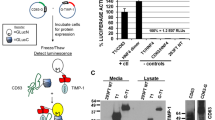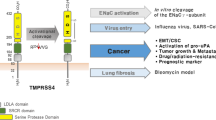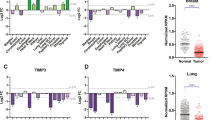Abstract
The matrix metalloproteinases (MMPs) mediate homeostasis of the extracellular environment. They have multiple signalling activities that are commonly altered during tumorigenesis and that might serve as intervention points for anticancer drugs. However, there are many criteria to consider in validating MMPs as drug targets and for the development of MMP inhibitors. The inhibition of some MMPs could have pro-tumorigenic effects (making them anti-targets), counterbalancing the benefits of target inhibition. These effects might partially account for the failure of MMP inhibitors in clinical trials. What are the major challenges in MMP target validation and MMP-inhibitor-drug development?
This is a preview of subscription content, access via your institution
Access options
Subscribe to this journal
Receive 12 print issues and online access
$209.00 per year
only $17.42 per issue
Buy this article
- Purchase on Springer Link
- Instant access to full article PDF
Prices may be subject to local taxes which are calculated during checkout


Similar content being viewed by others
References
Drews, J. Drug discovery: a historical perspective. Science 287, 1960–1964 (2000).
Lindsay, M. A. Target discovery. Nature Rev. Drug Discov. 2, 831–838 (2003).
Williams, M. Target validation. Curr. Opin. Pharmacol. 3, 571–577 (2003).
López-Otín, C. & Overall, C. M. Protease degradomics: a new challenge for proteomics. Nature Rev. Mol. Cell Biol. 3, 509–519 (2002).
Puente, X. S., Sanchez, L. M., Overall, C. M. & López-Otín, C. Human and mouse proteases: a comparative genomic approach. Nature Rev. Genet. 4, 544–558 (2003).
Koopec, K. K., Bozyczko-Coyne, D. & Williams, M. Target identification and validation in drug discovery: the role of proteomics. Biochem. Pharmacol. 69, 1133–1139 (2005).
Liotta, L. A. et al. Metastatic potential correlates with enzymatic degradation of basement membrane collagen. Nature 284, 67–68 (1980).
Stetler-Stevenson, W. G. Progelatinase A activation during tumor cell invasion. Invasion Metastasis 14, 259–268 (1994).
Nagase, H. & Woessner, J. F. Matrix metalloproteinases. J. Biol. Chem. 274, 21491–21494 (1999).
Egeblad, M. & Werb, Z. New functions for the matrix metalloproteinases in cancer progression. Nature Rev. Cancer 2, 161–174 (2002).
Minn, A. J. et al. Genes that mediate breast cancer metastasis to lung. Nature 436, 518–524 (2005).
Minn, A. J. et al. Distinct organ-specific metastatic potential of individual breast cancer cells and primary tumors. J. Clin. Invest. 115, 44–55 (2005).
Radisky, D. C. et al. Rac1b and reactive oxygen species mediate MMP-3-induced EMT and genomic instability. Nature 436, 123–127 (2005).
Weigelt, B., Peterse, J. L. & van't Veer, L. J. Breast cancer metastasis: markers and models. Nature Rev. Cancer 5, 591–602 (2005).
McCullagh, K., Wadsworth, H. & Hann, M. Carboxyalkyl peptide derivatives. European Patent EP126,974, 1–111 (1984).
Zucker, S., Cao, J. & Chen, W. T. Critical appraisal of the use of matrix metalloproteinase inhibitors in cancer treatment. Oncogene 19, 6642–6650 (2000).
Overall, C. M. & López-Otín, C. Strategies for MMP inhibition in cancer: innovations for the post-trial era. Nature Rev. Cancer 2, 657–672 (2002).
Coussens, L. M., Fingleton, B. & Matrisian, L. M. Matrix metalloproteinase inhibitors and cancer: trials and tribulations. Science 295, 2387–2392 (2002).
Fingleton, B. Matrix metalloproteinase inhibitors for cancer therapy: the current situation and future prospects. Expert Opin. Ther. Targets 7, 385–397 (2003).
Kumagai, K. et al. Inhibition of matrix metalloproteinases prevents allergen-induced airway inflammation in a murine model of asthma. J. Immunol. 162, 4212–4219 (1999).
McCawley, L. J. & Matrisian, L. M. Matrix metalloproteinases: they're not just for matrix anymore! Curr. Opin. Cell Biol. 13, 534–540 (2001).
Aoki, T., Sumii, T., Mori, T., Wang, X. & Lo, E. H. Blood–brain barrier disruption and matrix metalloproteinase-9 expression during reperfusion injury: mechanical versus embolic focal ischemia in spontaneously hypertensive rats. Stroke 33, 2711–2717 (2002).
Overall, C. M. Dilating the degradome: matrix metalloproteinase-2 cuts to the heart of the matter. Biochem. J. 383, E5–E7 (2004).
Parks, W. C., Wilson, C. L. & López-Boado, Y. S. Matrix metalloproteinases as modulators of inflammation and innate immunity. Nature Rev. Immunol 4, 617–629 (2004).
Bergers, G., Javaherian, K., Lo, K. M., Folkman, J. & Hanahan, D. Effects of angiogenesis inhibitors on multistage carcinogenesis in mice. Science 284, 808–812 (1999).
Boehm, T., Folkman, J., Browder, T. & O'Reilly, M. S. Antiangiogenic therapy of experimental cancer does not induce acquired drug resistance. Nature 390, 404–407 (1997).
McQuibban, G. A. et al. Matrix metalloproteinase activity inactivates the chemokine stromal-cell derived factor-1. J. Biol. Chem. 276, 43503–43508 (2001).
McQuibban, G. A. et al. Matrix metalloproteinase processing of monocyte chemoattractant proteins generates CC chemokine receptor antagonists with anti-inflammatory properties in vivo. Blood 100, 1160–1167 (2002).
Epstein, R. J. The CXCL12–CXCR4 chemotactic pathway as a target of adjuvant breast cancer therapies. Nature Rev. Cancer 4, 901–909 (2004).
Balkwill, F. Cancer and the chemokine network. Nature Rev. Cancer 4, 540–550 (2004).
Richardson, P. G. et al. A phase 2 study of bortezomib in relapsed, refractory myeloma. N. Engl. J. Med. 348, 2609–2617 (2003).
Overall, C. M. Molecular determinants of metalloproteinase substrate specificity: matrix metalloproteinase substrate binding domains, modules, and exosites. Mol. Biotechnol. 22, 51–86 (2002).
Topol, E. J. Failing the public health — Rofecoxib, Merck, and the FDA. N. Engl. J. Med. 351, 1707–1709 (2004).
Psaty, B. M. & Furburg, C. D. COX-2 inhibitors — lessons in drug safety. N. Engl. J. Med. 352, 1133–1135 (2005).
Tanne, J. H. Merck faces ongoing claims after Texan ruling on Rofecoxib. Br. Med. J. 331, 471 (2005).
Fidler, I. J. The pathogenesis of cancer metastasis: the 'seed and soil' hypothesis revisited. Nature Rev. Cancer 3, 453–458 (2003).
Sodek, J. & Overall, C. M. in The Biological Mechanisms of Tooth Eruption and Root Resorption (ed. Davidovitch, Z.) 303–311 (EBSCO Media, Birmingham, 1988).
Engelholm, L. H. et al. uPARAP/Endo180 is essential for cellular uptake of collagen and promotes fibroblast collagen adhesion. J. Cell Biol. 160, 1009–1015 (2003).
Curino, A. C. et al. Intracellular collagen degradation mediated by uPARAP/Endo180 is a major pathway of extracellular matrix turnover during malignancy. J. Cell Biol. 169, 977–985 (2005).
Schenk, S. & Quaranta, V. Tales from the crypt[ic] sites of the extracellular matrix. Trends Cell Biol. 13, 366–375 (2003).
Pirila, E. et al. Matrix metalloproteinases process the laminin-5 γ2-chain and regulate epithelial cell migration. Biochem. Biophys. Res. Commun. 303, 1012–1017 (2003).
Handsley, M. M. & Edwards, D. R. Metalloproteinases and their inhibitors in tumor angiogenesis. Int. J. Cancer 115, 849–860 (2005).
O'Reilly, M. S., Holmgren, L., Chen, C. & Folkman, J. Angiostatin induces and sustains dormancy of human primary tumors in mice. Nature Med. 2, 689–692 (1996).
Tam, E. M., Morrison, C. J., Wu, Y. I., Stack, M. S. & Overall, C. M. Membrane protease proteomics: isotope-coded affinity tag MS identification of undescribed MT1-matrix metalloproteinase substrates. Proc. Natl Acad. Sci. USA 101, 6917–6922 (2004).
Fingleton, B., Vargo-Gogola, T., Crawford, H. C. & Matrisian, L. M. Matrilysin (MMP-7) expression selects for cells with reduced sensitivity to apoptosis. Neoplasia 3, 459–468 (2001).
Balbin, M. et al. Loss of collagenase-2 confers increased skin tumor susceptibility to male mice. Nature Genet. 35, 252–257 (2003).
McQuibban, G. A. et al. Inflammation dampened by gelatinase A cleavage of monocyte chemoattractant protein-3. Science 289, 1202–1206 (2000).
Fowlkes, J. L., Thrailkill, K. M., Serra, D. M., Suzuki, K. & Nagase, H. Matrix metalloproteinases as insulin-like growth factor binding protein-degrading proteinases. Prog. Growth Factor Res. 6, 255–263 (1995).
Hemers, E. et al. Insulin-like growth factor binding protein-5 is a target of matrix metalloproteinase-7: implications for epithelial-mesenchymal signaling. Cancer Res. 65, 7363–7369 (2005).
Davies, N. M. & Jamali, F. COX-2 selective inhibitors cardiac toxicity: getting to the heart of the matter. J. Pharm. Pharm. Sci. 7, 332–336 (2004).
Khokha, R. et al. Antisense RNA-induced reduction in murine TIMP levels confers oncogenicity on Swiss 3T3 cells. Science 243, 947–950 (1989).
Hanahan, D. & Folkman, J. Patterns and emerging mechanisms of the angiogenic switch during tumorigenesis. Cell 86, 353–364 (1996).
Arbeit, J. M., Munger, K., Howley, P. M. & Hanahan, D. Progressive squamous epithelial neoplasia in K14-human papillomavirus type 16 transgenic mice. J. Virol. 68, 4358–4368 (1994).
Coussens, L. M. & Werb, Z. Inflammation and cancer. Nature 420, 860–867 (2002).
Ben-Baruch, A. Host microenvironment in breast cancer development: inflammatory cells, cytokines and chemokines in breast cancer progression: reciprocal tumor–microenvironment interactions. Breast Cancer Res. 5, 31–36 (2003).
Ben-Baruch, A. Inflammation-associated immune suppression in cancer: the roles played by cytokines, chemokines and additional mediators. Semin. Cancer Biol. 16, 38–52 (2006).
Brummelkamp, T. R., Bernards, R. & Agami, R. A system for stable expression of short interfering RNAs in mammalian cell. Science 296, 550–553 (2002).
Bramhall, S. R. et al. Marimastat as maintenance therapy for patients with advanced gastric cancer: a randomised trial. Br. J. Cancer 86, 1864–1870 (2002).
Bramhall, S. R. et al. A double-blind placebo-controlled, randomised study comparing gemcitabine and marimastat with gemcitabine and placebo as first line therapy in patients with advanced pancreatic cancer. Br. J. Cancer 87, 161–167 (2002).
Groves, M. D. et al. Phase II trial of temozolomide plus the matrix metalloproteinase inhibitor, marimastat, in recurrent and progressive glioblastoma multiforme. J. Clin. Oncol. 20, 1383–1388 (2002).
King, J., Zhao, J., Clingan, P. & Morris, D. Randomised double blind placebo control study of adjuvant treatment with the metalloproteinase inhibitor, Marimastat in patients with inoperable colorectal hepatic metastases: significant survival advantage in patients with musculoskeletal side-effects. Anticancer Res. 23, 639–645 (2003).
van't Veer, L. J. et al. Gene expression profiling predicts clinical outcome of breast cancer. Nature 415, 530–536 (2002).
Murray, G. I., Duncan, M. E., O'Neil, P., Melvin, W. T. & Fothergill, J. E. Matrix metalloproteinase-1 is associated with poor prognosis in colorectal cancer. Nature Med. 2, 461–462 (1996).
Itoh, T. et al. Reduced angiogenesis and tumor progression in gelatinase A-deficient mice. Cancer Res. 58, 1048–1051 (1998).
Kruger, A. et al. Antimetastatic activity of a novel mechanism-based gelatinase inhibitor. Cancer Res. 65, 3523–356 (2005).
Tester, A. M. et al. Pro-matrix metalloproteinase-2 transfection increases orthotopic primary growth and experimental metastasis of MDA-MB-231 human breast cancer cells in nude mice. Cancer Res. 64, 652–658 (2004).
Bergers, G. et al. Matrix metalloproteinase-9 triggers the angiogenic switch during carcinogenesis. Nature Cell Biol. 2, 737–744 (2000).
Davidson, B. et al. Altered expression of metastasis-associated and regulatory molecules in effusions from breast cancer patients: a novel model for tumor progression. Clin. Cancer Res. 10, 7335–7346 (2004).
Wilson, C. L., Heppner, K. J., Labosky, P. A., Hogan, B. L. & Matrisian, L. M. Intestinal tumorigenesis is suppressed in mice lacking the metalloproteinase matrilysin. Proc. Natl Acad. Sci. USA 94, 1402–1407 (1997).
Crawford, H. C., Scoggins, C. R., Washington, M. K. & Matrisian, L. M. Matrix metalloproteinase-7 is expressed by pancreatic cancer precursors and regulates acinar-to-ductal metaplasia in exocrine pancrease. J. Clin. Invest. 109, 1437–1344 (2002).
Wagenaar-Miller, R. A. et al. Cooperative effects of matrix metalloproteinase and cyclooxygenase-2 inhibition on intestinal adenoma reduction. Br. J. Cancer 88, 1445–1452 (2003).
Montel, V. et al. Altered metastatic behavior of human breast cancer cells after experimental manipulation of matrix metalloproteinase 8 gene expression. Cancer Res. 64, 1687–1694 (2004).
Coussens, L. M., Tinkle, C. L., Hanahan, D. & Werb, Z. MMP-9 supplied by bone marrow-derived cells contributes to skin carcinogenesis. Cell 103, 481–490 (2000).
Witty, J. P., Lempka, T., Coffey, R. J. Jr & Matrisian, L. M. Decreased tumor formation in 7,12-dimethylbenzanthracene-treated stromelysin-1 transgenic mice is associated with alterations in mammary epithelial cell apoptosis. Cancer Res. 55, 1401–1406 (1995).
McCawley, L. J., Crawford, H. C., King, L. E. Jr, Mudgett, J. & Matrisian, L. M. A protective role for matrix metalloproteinase-3 in squamous cell carcinoma. Cancer Res. 64, 6965–6972 (2004).
Gorrin Rivas, M. J. et al. Expression of human macrophage metalloelastase gene in hepatocellular carcinoma: correlation with angiostatin generation and its clinical significance. Hepatology 28, 986–993 (1998).
Yang, W. et al. Human macrophage metalloelastase gene expression in colorectal carcinoma and its clinicopathologic significance. Cancer 91, 1277–1283 (2001).
Overall, C. M. & Sodek, J. Concanavalin A produces a matrix-degradative phenotype in human fibroblasts. Induction and endogenous activation of collagenase, 72-kDa gelatinase, and Pump-1 is accompanied by the suppression of the tissue inhibitor of matrix metalloproteinases. J. Biol. Chem. 265, 21141–21151 (1990).
Holmbeck, K. et al. MT1-MMP-deficient mice develop dwarfism, osteopenia, arthritis, and connective tissue disease due to inadequate collagen turnover. Cell 99, 81–92 (1999).
Tam, E. M., Moore, T. R., Butler, G. S. & Overall, C. M. Characterization of the distinct collagen binding, helicase and cleavage mechanisms of matrix metalloproteinase 2 and 14 (gelatinase A and MT1-MMP): the differential roles of the MMP hemopexin C domains and the MMP-2 fibronectin type II modules in collagen triple helicase activities. J. Biol. Chem. 279, 43336–4344 (2004).
Overall, C. M. et al. Protease degradomics: mass spectrometry discovery of protease substrates and the CLIP-CHIP, a dedicated DNA microarray of all human proteases and inhibitors. Biol. Chem. 385, 493–504 (2004).
Kang, Y. et al. A multigenic program mediating breast cancer metastasis to bone. Cancer Cell 3, 537–549 (2003).
Muller, A. et al. Involvement of chemokine receptors in breast cancer metastasis. Nature 410, 50–56 (2001).
Nevo, I. et al. The tumor microenvironment: CXCR4 is associated with distinct protein expression patterns in neuroblastoma cells. Immunol. Lett. 92, 163–169 (2004).
Zhang, K. et al. Metalloproteinase cleavage of the chemokine SDF-1α induces neuronal apoptosis in HIV encephalitis. Nature Neurosci. 6, 1064–1071 (2003).
Neumark, E., Sagi-Assif, O., Shalmon, B., Ben-Baruch, A. & Witz, I. P. Progression of mouse mammary tumors: MCP-1-TNFα cross-regulatory pathway and clonal expression of promalignancy and antimalignancy factors. Int. J. Cancer 106, 879–886 (2003).
Basset, P. et al. A novel metalloproteinase gene specifically expressed in stromal cells of breast carcinomas. Nature 348, 699–704 (1990).
Boulay, A. et al. High cancer cell death in syngeneic tumors developed in host mice deficient for the stromelysin-3 matrix metalloproteinase. Cancer Res. 61, 2189–2193 (2001).
Andarawewa, K. L. et al. Stromelysin-3 is a potent negative regulator of adipogenesis participating to cancer cell–adipocyte interaction/crosstalk at the tumor invasive front. Cancer Res. 65, 10862–10871 (2005).
Deng, H., Guo, R. F., Li, W. M., Zhao, M. & Lu, Y. Y. Matrix metalloproteinase 11 depletion inhibits cell proliferation in gastric cancer cells. Biochem. Biophys. Res. Commun. 326, 274–281 (2005).
Pendas, A. M. et al. Diet-induced obesity and reduced skin cancer susceptibility in matrix metalloproteinase 19-deficient mice. Mol. Cell Biol. 24, 5304–5313 (2004).
Kang, T. et al. Subcellular distribution and cytokine- and chemokine-regulated secretion of leukolysin/MT6-MMP/MMP-25 in neutrophils. J. Biol. Chem. 276, 21960–21968 (2001).
Gururajan, R., Grenet, J., Lahti, J. M. & Kidd, V. J. Isolation and characterization of two novel metalloproteinase genes linked to the Cdc2L locus on human chromosome 1p36.3. Genomics 52, 101–106 (1998).
Porter, S. et al. Dysregulated expression of adamalysin-thrombospondin genes in human breast carcinoma. Clin. Cancer Res. 10, 2429–2440 (2004).
Riddick, A. C. et al. Identification of degradome components associated with prostate cancer progression by expression analysis of human prostatic tissues. Br. J. Cancer 92, 2171–2180 (2005).
Greenbaum, D., Medzihradszky, K. F., Burlingame, A. & Bogyo, M. Epoxide electrophiles as activity-dependent cysteine protease profiling and discovery tools. Chem. Biol. 7, 569–581 (2000).
Abersold, R. & Mann, M. Mass spectrometry-based proteomics. Nature 422, 198–207 (2003).
De Leenheer, A. P. & Thienpont, L. M. Application of isotope dilution-mass spectrometry in clinical chemistry, pharmacokinetics, and toxicology. Mass Spectrom. Rev. 11, 249–307 (1992).
Gygi, S. P. et al. Quantitative analysis of complex protein mixtures using isotope-coded affinity tags. Nature Biotechnol. 17, 994–999 (1999).
Saghatelian, A., Jessani, N., Joseph, A., Humphrey, M. & Cravatt, B. F. Activity-based probes for the proteomic profiling of metalloproteases. Proc. Natl Acad. Sci. USA 101, 10000–10005 (2004).
Puerta, D. T. & Cohen, S. M. Examination of novel zinc-binding groups for use in matrix metalloproteinase inhibitors. Inorg. Chem. 42, 3423–3430 (2003).
Matziari, M., Beau, F., Cuniasse, P., Dive, V. & Yiotakis, A. Evaluation of P1′-diversified phosphinic peptides leads to the development of highly selective inhibitors of MMP-11. J. Med. Chem. 47, 325–336 (2004).
Cuniasse, P. et al. Future challenges facing the development of specific active-site-directed synthetic inhibitors of MMPs. Biochimie 87, 393–402 (2005).
Bertini, I. et al. Conformational variability of matrix metalloproteinases: beyond a single 3D structure. Proc. Natl Acad. Sci. USA 102, 5334–5339 (2005).
Moy, F. J. et al. Impact of mobility on structure-based drug design for the MMPs. J. Am. Chem. Soc. 124, 12658–12659 (2002).
Morales, R. et al. Crystal structures of novel non-peptidic, non-zinc chelating inhibitors bound to MMP-12. J. Mol. Biol. 341, 1063–1076 (2004).
Dublanchet, A. C. et al. Structure-based design and synthesis of novel non-zinc chelating MMP-12 inhibitors. Bioorg. Med. Chem. Lett. 15, 3787–3790 (2005).
Lukacova, V. et al. Similarity of binding sites of human matrix metalloproteinases. J. Biol. Chem. 279, 14194–14200 (2004).
Butler, G. S. & Overall, C. M. Proteomic validation of protease drug targets. Pharmacoproteomics of matrix metalloproteinase inhibitor drugs using isotope-coded affinity tag labelling and tandem mass spectrometry. Curr. Pharm. Des. (in the press).
Overall, C. M. & Kleifeld, O. Towards third generation matrix metalloproteinase inhibitors for cancer therapy. Br. J. Cancer (in the press).
Acknowledgements
This work was supported by grants from the National Cancer Institute of Canada with funds raised by the Canadian Cancer Association, the Canadian Breast Cancer Research Alliance special programme grant on metastasis, and with a Centre Grant from the Michael Smith Research Foundation. We gratefully acknowledgement the useful discussions of these concepts with Joerg Eder, Novartis Institutes of Biomedical Research, Basel, Switzerland.
Author information
Authors and Affiliations
Corresponding author
Ethics declarations
Competing interests
The authors declare no competing financial interests.
Related links
Related links
DATABASES
National Cancer Institute
FURTHER INFORMATION
Christopher Overall's laboratory, web page
Human, mouse and rat degradomes
Rights and permissions
About this article
Cite this article
Overall, C., Kleifeld, O. Validating matrix metalloproteinases as drug targets and anti-targets for cancer therapy. Nat Rev Cancer 6, 227–239 (2006). https://doi.org/10.1038/nrc1821
Issue Date:
DOI: https://doi.org/10.1038/nrc1821
This article is cited by
-
Perineural invasion in colorectal cancer: mechanisms of action and clinical relevance
Cellular Oncology (2024)
-
Regulatory cells and the effect of cancer immunotherapy
Molecular Cancer (2023)
-
Matrix metalloproteinases in arthritis: towards precision medicine
Nature Reviews Rheumatology (2023)
-
Utilizing genetic code expansion to modify N-TIMP2 specificity towards MMP-2, MMP-9, and MMP-14
Scientific Reports (2023)
-
Inhibition of MMP2-PEX by a novel ester of dihydroxy cinnamic and linoleic acid from the seagrass Cymodocea serrulata
Scientific Reports (2021)



